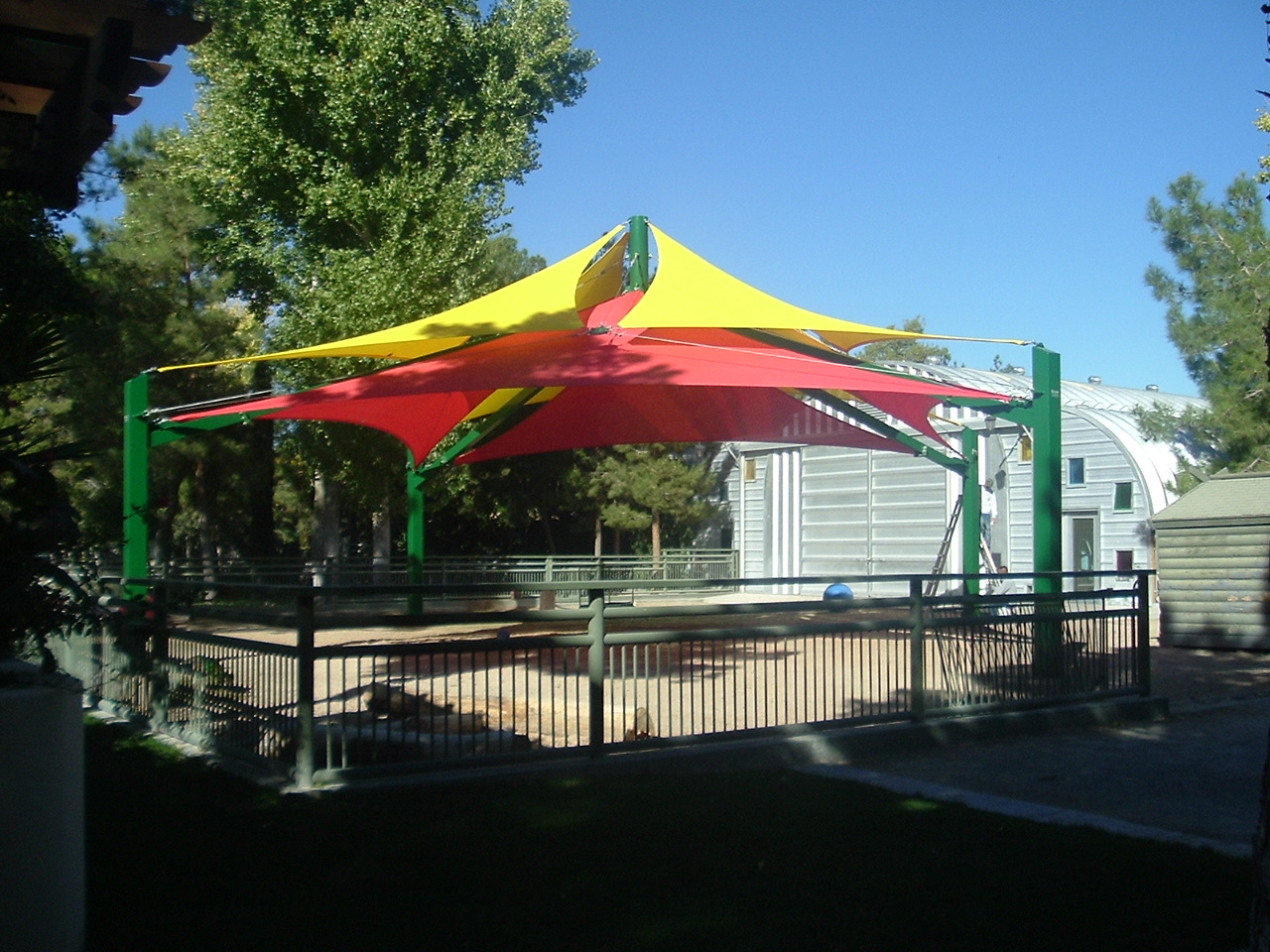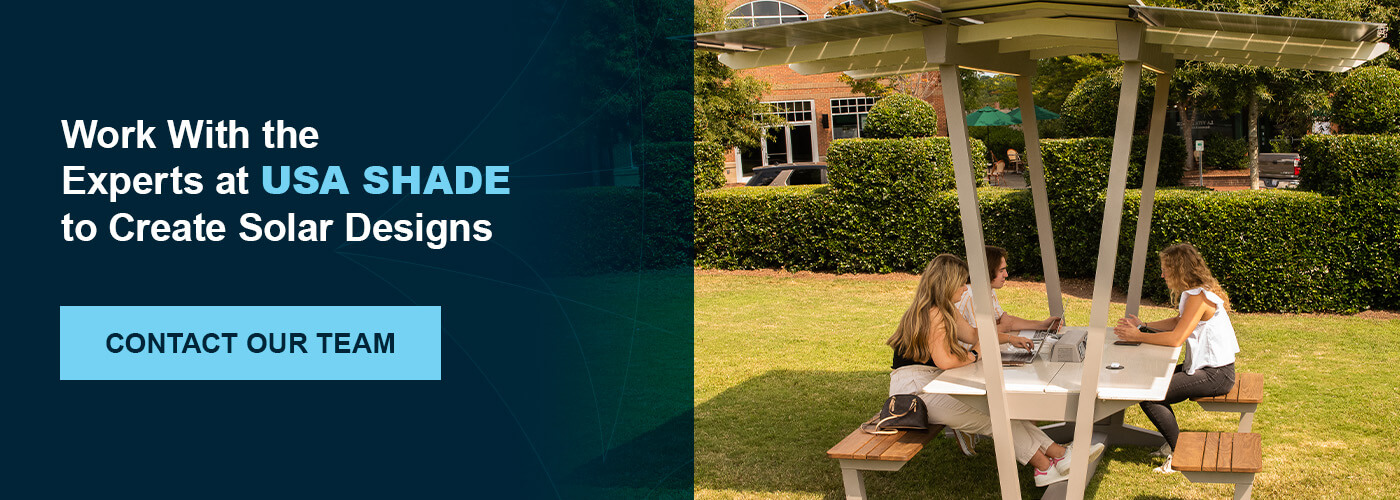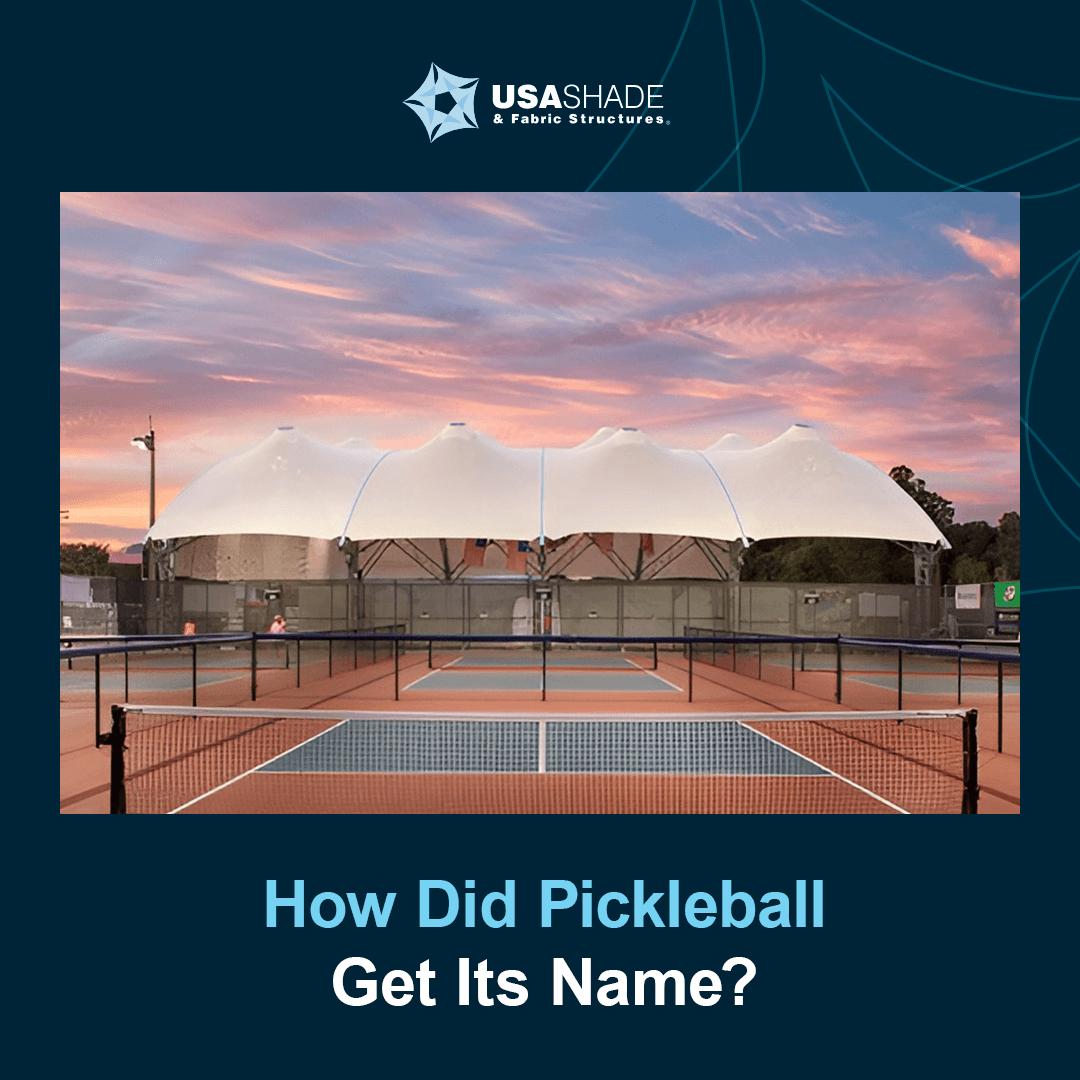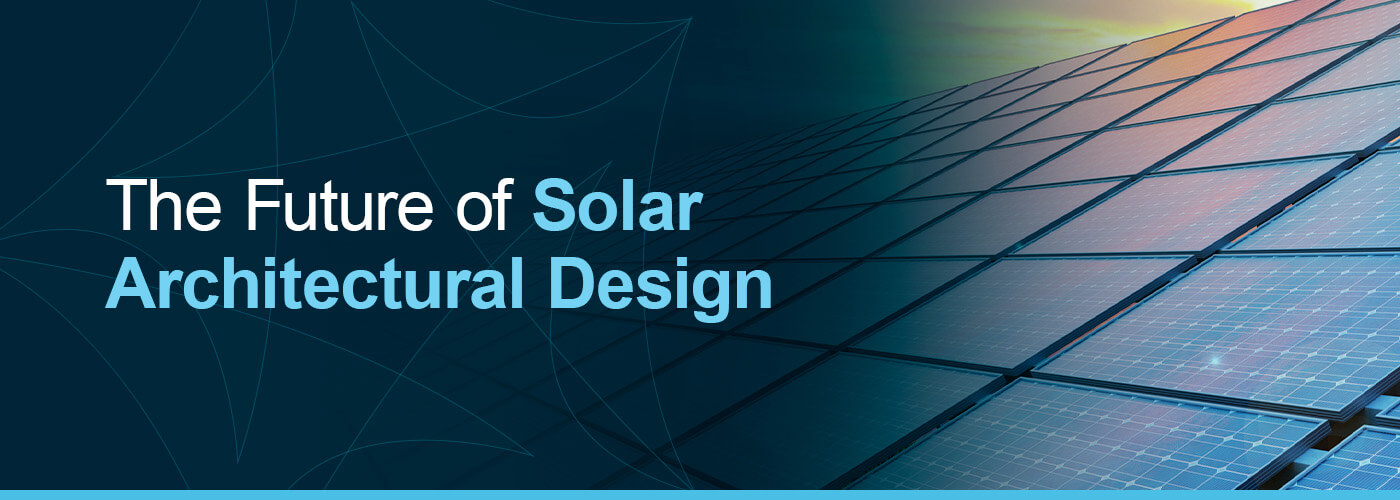

Traditionally, when we think of solar-powered homes or businesses, bulky solar panels on rooftops come to mind. However, with solar architecture on the rise, business owners no longer have to compromise beauty for the benefits of solar energy systems.
If you’re not quite sure what solar architecture is, we’ve got you covered. From a brief history to the various benefits and ways to use solar architecture, our complete guide covers it all. Read on to see how architectural solar panels can benefit your client’s business.
A Brief History of Solar Architecture
Just before World War II, architects in the Midwest, Southwest and Northeast regions of the United States began to experiment with solar homes. The solar home experiment worked with the Ford Foundation and other international aid organizations to develop the technology used for solar power today. During and after the war, anxiety about energy supplies ran high among home and business owners.
Additionally, the shifting culture in the 1960s and 1970s increased the interest in solar energy and other environmentally friendly practices. While the interest in solar-powered homes and buildings was strong, the challenge became how to incorporate solar structures into a building’s architecture. Eventually, architects developed a passive solar design. Once the solar panels are incorporated into the architecture and construction, passive solar design does not require any additional mechanical processes.
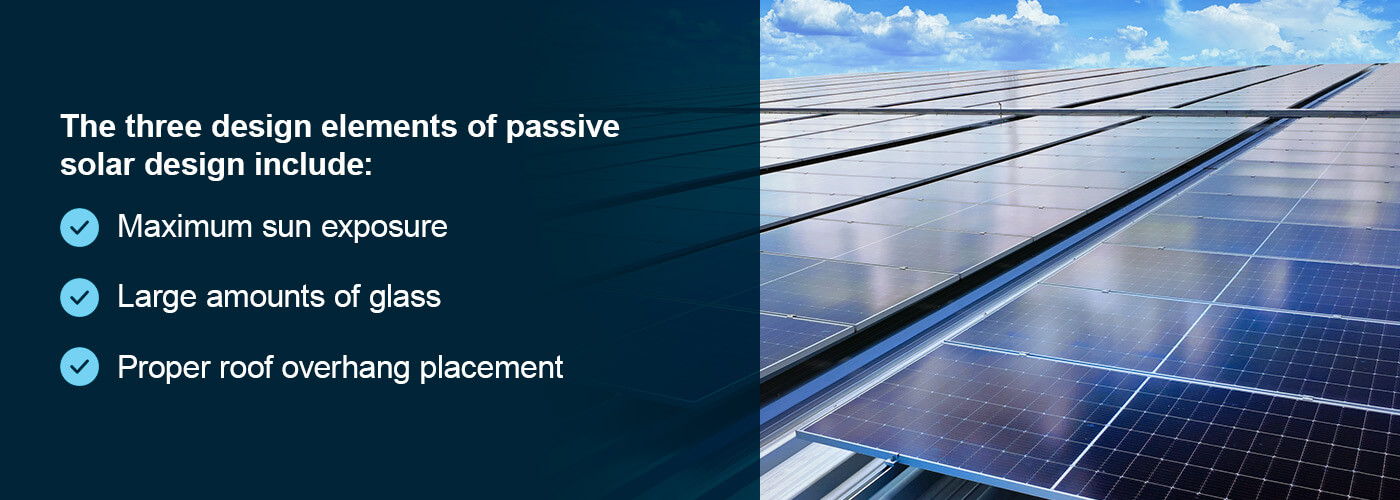

The three design elements of passive solar design include:
- Maximum sun exposure: The majority of the living areas are designed to face the south to ensure maximum exposure to the sun. These homes are designed to be narrow and stretched out, again for more sun exposure.
- Large amounts of glass: By using a lot of glass within the home or building’s design, the sun’s light and heat can better penetrate the home. This can help reduce the need for electric lighting or heating.
- Proper roof overhang placement: With the carefully designed and placed roof overhang, the home or building can be protected from overheating as the overhang blocks the hot, peak-time summer sun. The overhang also allows for the warmth and sun exposure of the lower winter sun to still make its way into the home.
Through experience, architects began to find areas of improvement for their designs. For example, while a glass-heavy design helped bring warmth into the home, it had trouble keeping that warmth in. Architects then had to develop better insulation methods to keep the heat inside. The more architects worked with solar design, the more they learned and the more innovative and effective their designs became.
How Popular Is Solar-Based Design Today?
In 2022 solar photovoltaic (solar PV) systems produced 4.5% of the global electricity generation. This energy production increased 24% from the previous year’s levels. This makes solar PV the third-largest renewable energy source. So, yes, solar-based designs continue to increase in popularity each year. In fact, based on current trends, it’s predicted that 45% of the United States’ electricity will come from solar energy by 2050.
As homeowners and business owners become more interested in adding solar PV systems, the need for solar-based architecture increases. Without an innovative design, solar panels can be a distracting aspect of a home or building. That’s why solar-based architecture designs continue to rise in popularity. Why wouldn’t homeowners and business owners want to enjoy a beautiful and functional solar design?
Solar architects are now able to bring together the benefits of solar PV systems and the beauty of architecture. People no longer need to sacrifice their home or business’s exterior design for solar energy systems.
Ways to Rethink Solar Design
As solar energy systems continue to rise in popularity, it’s vital to find innovative ways to incorporate these systems into homes and commercial building architecture. Functionality is essential, but the design and overall look of a building or home are also extremely valuable and deserve the same consideration. Solar architecture gives users functional benefits while also providing a beautiful building design.
As architectural solar panels continue to evolve and improve, consider some of the following innovative solar panel ideas and designs.
1. Add Solar Design to Nontraditional Spaces
Solar design may bring to mind homes or businesses with solar panels on their roofing, but the applications for solar panels are much more diverse than just rooftops. Smaller areas can also make a great spot for solar panels. Think sheds, greenhouses and garages.
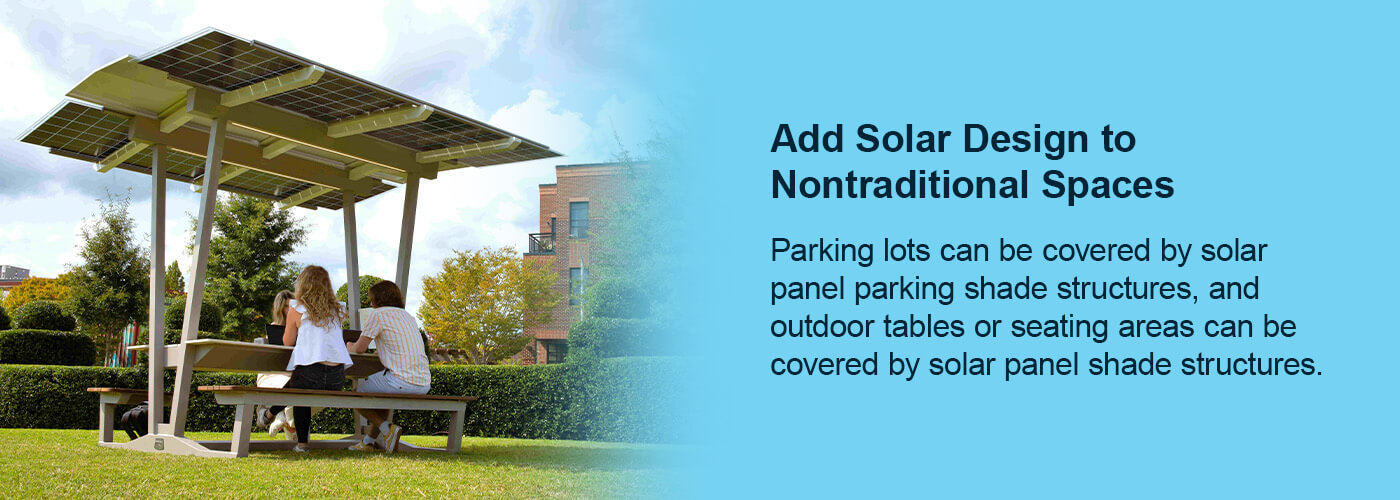

Open areas can also be an ideal spot for solar energy systems. Parking lots can be covered by solar panel parking shade structures, and outdoor tables or seating areas can be covered by solar panel shade structures. Whether your client’s business wants to add solar panels to an existing structure or add a new solar panel structure to the property, don’t be afraid to get creative on where they can go. Open or empty space can be an opportunity to add solar panels that can generate energy, save your clients money and give new purpose to the area.
2. Adapt Solar Designs to the Sun
Consider making sure the design adapts its shape to the movement of the sun’s path. Designing around the sun’s path is not a new concept in architecture. However, it does have an increased importance for buildings with solar panels. Sun path architecture takes the building’s location and position — plus the sun’s natural path — into consideration.
By understanding the sun’s path, solar panels can be strategically placed to absorb the most sunlight possible — even as the sun shifts throughout the day. While the sun rises in the east and sets in the west, the actual sun path can vary by location. With solar sun path architecture, an architect can create a design that works for a building’s specific sun path, ensuring the best energy absorption and a beautiful design.
3. Use Solar Panels as Shade Structures
Has your client ever considered a separate solar panel structure that can also act as a shaded area for people to gather? That’s right — solar panels don’t have to only be on a building rooftop or a grounded structure. An innovative and multifunctional design has brought together all of the benefits of solar panels and shade structures into one high-quality product. This combined structure is known as Haven™ Solar Structure.
These solar panel canopies allow your client’s business to provide customers and guests with a cool, shaded area. Add tables and benches or chairs to allow people to sit and eat, study, work or chat with friends. While providing visitors with a place to sit on the property, your client’s business will also be generating energy to lower the facility’s energy bills. In other words, while providing visitors with a service, the business is also benefiting from the structure.
Here are some benefits of Haven Solar Canopies.
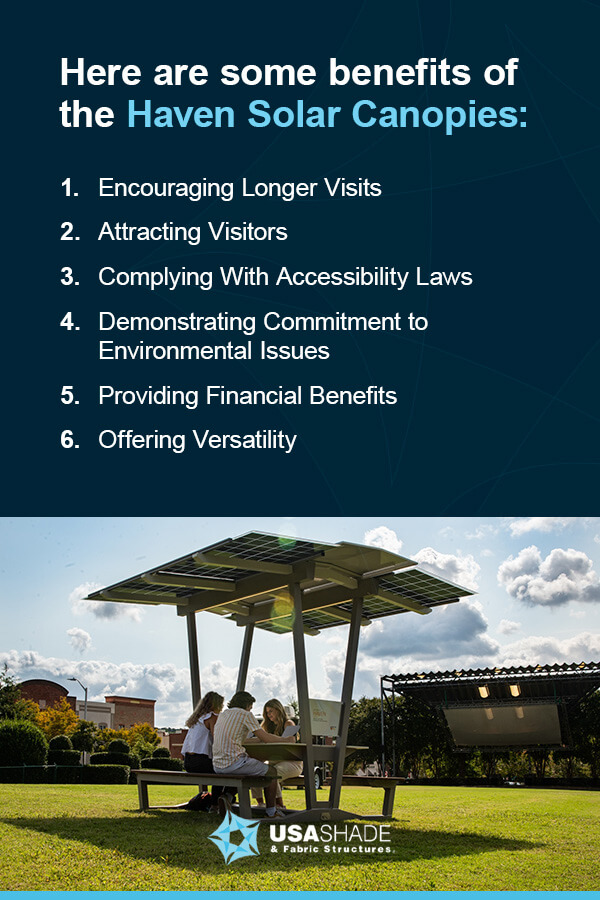

Encouraging Longer Visits
When an outdoor space provides shaded areas for guests, they are more likely to stay longer than they would at an unshaded space. Shaded areas allow visitors to remain cooler in the summer heat while also protecting them from harmful UV rays. Additionally, if the shade structure also includes electrical outlets — powered by solar panels, of course — guests will be encouraged to stay longer since they won’t have to leave to recharge a dead phone, laptop or tablet.
Attracting Visitors
Just as a solar panel shade structure encourages visitors to stay, it can also draw new visitors in. A shaded seating area with charging ports is a preferred option for most visitors, so if your client’s business offers this, you can expect to see people come specifically for this amenity.
Complying With Accessibility Laws
Haven solar canopy is designed with a split bench to accommodate people who use wheelchairs. Overall, this canopy is designed to meet all the guidelines set by the Americans with Disabilities Act (ADA).
Demonstrating Commitment to Environmental Issues
Including a solar-panel-powered structure on the property shows customers your client’s eco-friendly commitment. To go above and beyond, Haven also offers digital messaging or signage to further illustrate dedication to eco-friendly practices. This is more important than ever, as consumers increasingly value a business’s corporate social responsibility (CSR) efforts. In fact, 55% of Americans feel businesses should take a stance on environmental, social and political issues.
Providing Financial Benefits
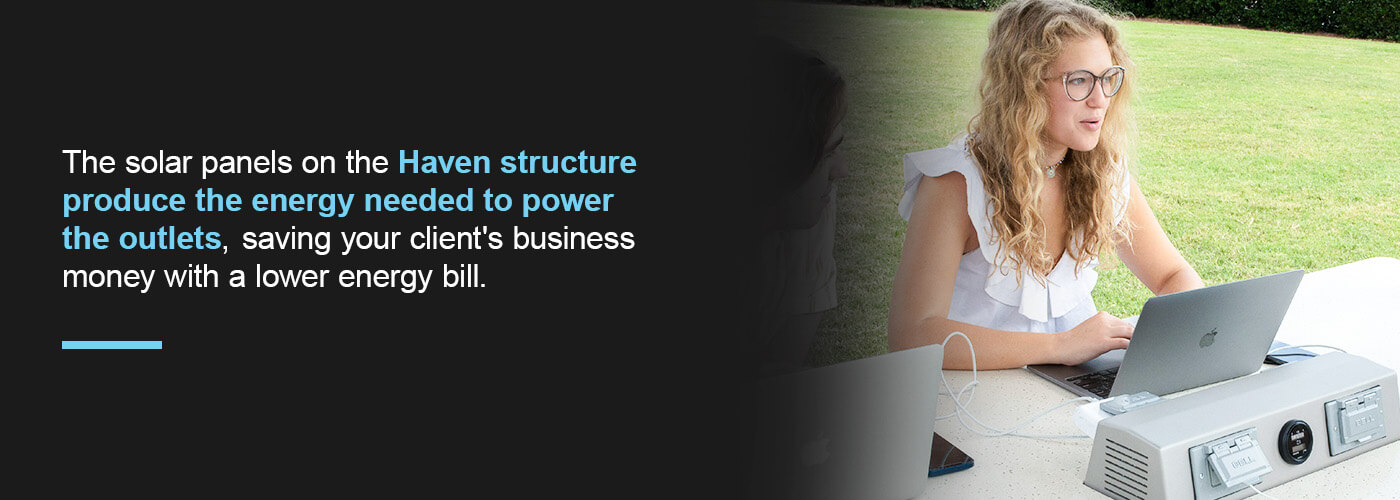

The solar panels on Haven structure produce the energy needed to power the outlets, saving your client’s business money with a lower energy bill. Additionally, there are several federal, state and local programs that can provide financial or tax credits and other benefits as a reward for installing a clean energy structure.
Offering Versatility
Haven solar shade structure can benefit a variety of businesses. From relaxing outdoor spaces to high-traffic areas, Haven solar canopy can be a great addition to the following commercial spaces:
- Corporate offices: Inspire staff with an outdoor space where they can still stay connected to power outlets to charge laptops and other work devices. This can help boost morale and provides a nice area for staff to work together, gather for lunch and more.
- Parks and recreational areas: Provide visitors with a place to rest and enjoy the beauty of nature. Here, visitors may stop to rest for a drink of water after a workout, catch up with friends over a picnic or charge their devices to capture the perfect shot of the sunset.
- Restaurants: Take a restaurant’s outdoor seating area to the next level with a solar-powered shade structure. Restaurant guests will love the convenience and shade the structure provides, while business managers will enjoy a lower energy bill. That’s right — restaurants can use the structures for power, too, so plug in those string lights to set the mood during the evening hours.
- Hotels: From families on vacation to guests traveling for work, a powered outdoor space allows hotel guests to get outside while staying connected. Your client can add shaded outdoor areas to their amenity list to inform potential guests of this addition.
- Music venues: Outdoor music venues require a lot of energy, and Haven structure can help. Keep cameras charged to live stream the event, offer charging spots for guests and more with the addition of a few Haven solar shade structures around the property.
- Schools: Students of all ages can benefit from an outdoor classroom, from elementary to college. Haven structures are the perfect solution for outdoor classrooms since they provide seating, power and shade. Kids can stay connected and work on online assignments outdoors while staying cool in the shade. The shade can also help reduce eyestrain by blocking the direct sunlight.
4. Incorporate Hidden Solar Panel Designs
While solar panels are very beneficial, some exterior designs may not benefit from the panels’ appearance. Luckily, there are ways to incorporate solar panels into the building in a more discreet way that provides the business with the benefits they need and the look they want.
When trying to place a discreet solar panel, think of the height and angle of the placement. Tall buildings can place solar panels on the roof since passersby will not be able to see the top of the building. For smaller buildings or buildings with an angled roof, it’s best to place the panels in a spot with the least amount of visibility.
In other words, place the solar panel in a spot less people will see, like the back of the building or the side of the building. Try to keep the front of the building clear to maintain a discreet look. This way, people passing by may not even know the building has solar panels.
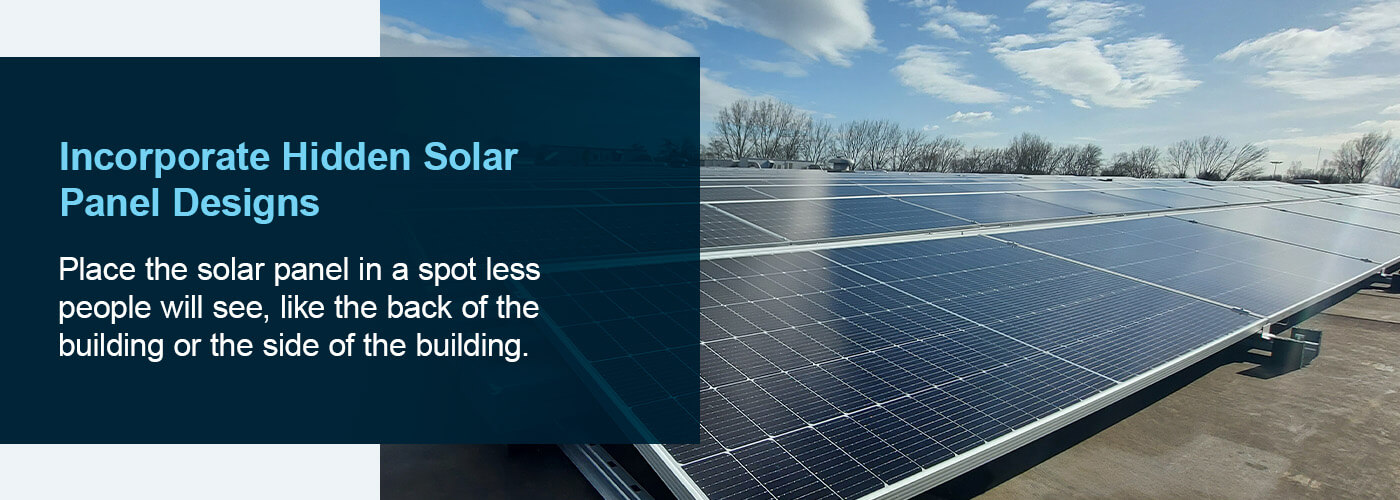

Also, consider the angle of the solar panel. Is it placed in a way that will reflect the sun and draw attention? Minimizing reflection will minimize the amount of attention brought to the solar panel, giving the building’s solar energy system a more discreet look.
The Importance of Adding Solar Components to Architectural Design
Adding solar components to architectural design allows businesses to benefit in a variety of ways, including complying with legal requirements, positively impacting the environment and saving money. Solar components can also provide a variety of other benefits, but let’s take a closer look at three of the biggest benefits.
Complies With Legal Requirements
For some businesses, installing solar components is not a suggestion but a requirement. For example, the California Building Standards Commission declared a mandate in 2020 that required all new residential construction projects to have solar panels or solar PV systems. From single-family homes to apartment buildings, all new construction requires a solar PV system.
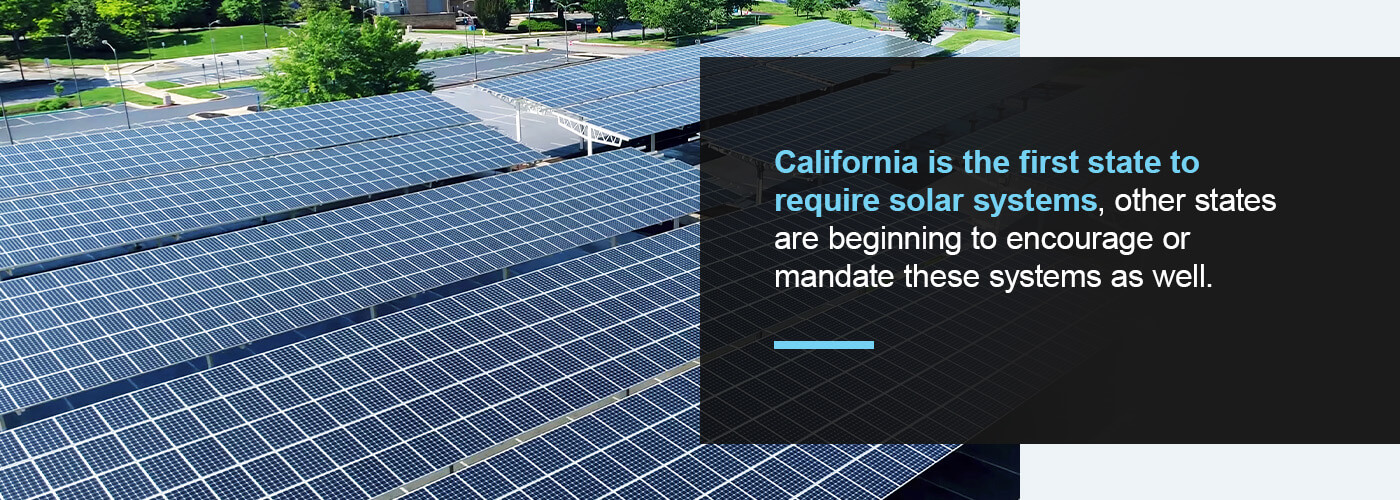

California remains a leader in clean energy efforts, and the local and state mandates surrounding solar panels continue to update every three years. While California is the first state to require solar systems, other states are beginning to encourage or mandate these systems as well. So, businesses under construction may not have a choice whether or not they include solar panels in their architecture.
Check local, state and federal requirements for your client’s specific location to ensure their building complies with all mandates, laws and codes.
Benefits the Environment
When listing the benefits of solar panels, it’s impossible to neglect to mention the impact they have on the environment. Solar energy can help protect the environment, humans, ecosystems and wildlife by reducing greenhouse gas emissions and mitigating the effects of climate change.
Other solar panel environmental benefits include:
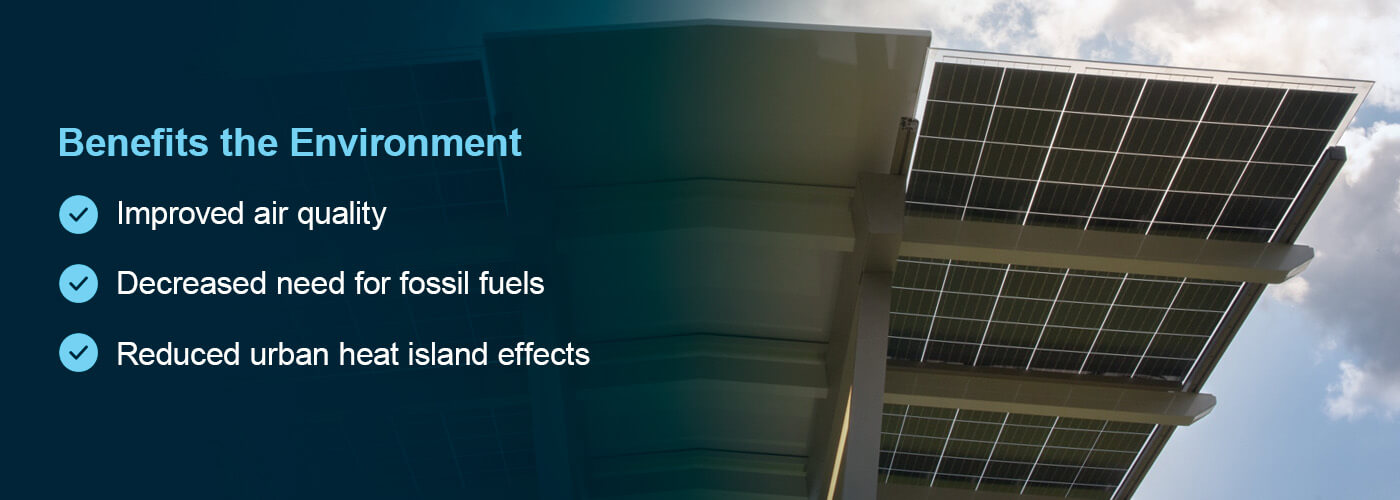

- Improved air quality: The Office of Energy Efficiency and Renewable Energy reports that widespread use of solar energy can improve air quality. Solar energy leads to a significant decrease in emissions, including sulfur dioxide, nitrous oxides, mercury and more.
- Decreased need for fossil fuels: With a clean energy source like solar energy, we can reduce the need for fossil fuels. This leads to fewer greenhouse gas emissions and other pollutants.
- Reduced urban heat island effects: Urban heat islands occur when a city absorbs and retains heat in buildings, pavement and other surfaces. This leads to more uncomfortable temperatures, increased energy costs and air pollution levels, and more. Luckily, solar panels can help mitigate the effects of urban heat islands.
Solar panels offer renewable, clean and emission-free energy for businesses and homes. Solar energy, especially as it becomes more widespread, can benefit the overall health and wellness of the planet.
Offers Financial Benefits
Solar energy helps the planet and can directly benefit homeowners or business owners who utilize it. Homes or businesses that incorporate solar energy systems can benefit financially and enjoy tax credits, lower energy bills, net metering and a high return on investment (ROI).
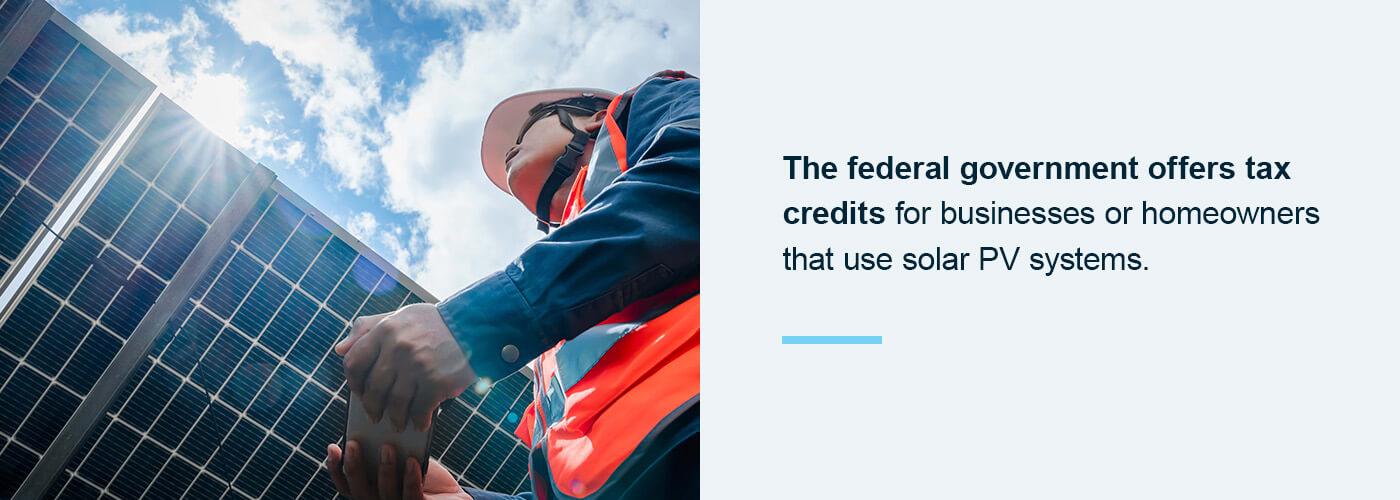

The federal government offers tax credits for businesses or homeowners that use solar PV systems. Businesses can qualify for one of two tax credits:
- The investment tax credit (ITC): This tax credit reduces the business’s federal income tax liability by a percentage of the total cost of installing the system. This credit must be claimed during the year the system is installed.
- The production tax credit (PTC): The PTC gives businesses a tax credit every year for the first 10 years after the system’s installation. The federal income tax liability is reduced based on the amount of electricity generated per kilowatt-hour. This tax credit is adjusted for inflation annually.
Homeowners can also benefit from the ITC. However, business ITCs and homeowner ITCs are slightly different.
In addition to tax credits, businesses can also save on monthly electricity expenses. Since the solar PV system generates energy, businesses can use this energy to run — or help run — daily operations. By supplying your client’s business with its own energy, clients can save a significant amount on electricity expenses.
Beyond that, if a business’s solar energy system produces more energy than the business needs, the extra energy can be sold back to the grid. Selling energy back is known as net metering. By installing a solar PV system, your client’s business can benefit from another revenue stream.
While it is not guaranteed the business will make more energy than it needs, solar architecture can be used to maximize the solar PV system’s surface area by getting creative with the panels’ placement. This can help increase the likelihood of net metering. Solar architecture can also ensure the solar PV system is placed in the most strategic and beneficial areas of the building or property.
Overall, solar-based designs allow businesses to continue to benefit from solar energy for years after installation. With a high ROI and other various financial benefits, it’s clear solar architecture is a smart business move.
Work With the Experts at USA SHADE to Create Solar Designs
Add beautifully designed solar shade structures to your client’s business with the help of USA SHADE. Our team values beauty and functionality, so businesses can expect a product they love with the functionality they need. We also offer customization options to help you get the perfect product for your client’s needs. From design development to construction, we’ll be with you every step of the way, and you can use our Architectural Studio to get inspired. See how USA SHADE can bring solar shade structures to your client’s business, and contact our team today.


